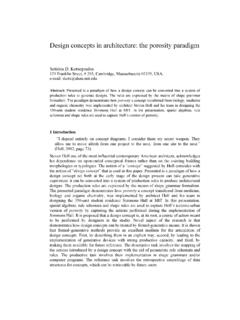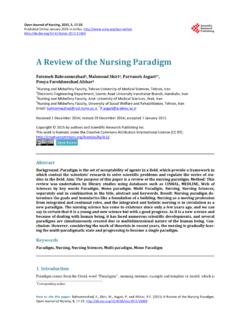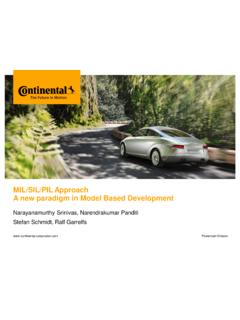Transcription of Object-Oriented Analysis & Design - tutorialspoint.com
1 Object-Oriented Analysis & Design i Object-Oriented Analysis & Design About the Tutorial This tutorial will help you understand the basics of Object-Oriented Analysis and Design along with its associated terminologies. Audience This tutorial has been designed to help beginners. After completing this tutorial, you will find yourself at a moderate level of expertise from where you can take yourself to next levels. Prerequisites Before you start proceeding with this tutorial, it is assumed that you have basic understanding of computer programming and related programming paradigms. Copyright & Disclaimer Copyright 2014 by Tutorials Point (I) Pvt. Ltd. All the content and graphics published in this e-book are the property of Tutorials Point (I) Pvt. Ltd. The user of this e-book is prohibited to reuse, retain, copy, distribute or republish any contents or a part of contents of this e-book in any manner without written consent of the publisher.
2 We strive to update the contents of our website and tutorials as timely and as precisely as possible, however, the contents may contain inaccuracies or errors. Tutorials Point (I). Pvt. Ltd. provides no guarantee regarding the accuracy, timeliness or completeness of our website or its contents including this tutorial. If you discover any errors on our website or in this tutorial, please notify us at i Object-Oriented Analysis & Design Table of Contents About the Tutorial ..i Audience ..i Prerequisites ..i Copyright & Disclaimer ..i Table of Contents ..ii 1. OOAD Object-Oriented paradigm .. 1. A Brief History ..1. Object-Oriented Analysis ..1. Object-Oriented Design ..2. Object-Oriented Programming ..2. 2. OOAD OBJECT MODEL .. 3. Objects and Classes ..3. Encapsulation and Data Hiding ..4. Message Passing.
3 4. Inheritance ..5. Polymorphism ..6. Generalization and Specialization ..7. Links and Association ..7. Aggregation or Benefits of Object Model ..8. 3. OOAD Object-Oriented SYSTEM .. 10. Phases in Object-Oriented Software Development ..10. 4. OOAD Object-Oriented PRINCIPLES .. 12. ii Object-Oriented Analysis & Design Principles of Object-Oriented Systems ..12. Abstraction ..12. Encapsulation ..12. Modularity ..13. Typing ..13. Concurrency ..13. Persistence ..14. 5. OOAD Object-Oriented Analysis .. 15. Object Dynamic Modelling ..15. Functional Modelling ..16. Structured Analysis vs. Object-Oriented Analysis ..16. Advantages/Disadvantages of Object-Oriented Analysis ..16. Advantages/Disadvantages of Structured Analysis ..17. 6. OOAD DYNAMIC MODELLING .. 18. States and State Transitions ..18. Events.
4 19. Actions ..20. Diagrams for Dynamic Modelling ..21. Concurrency of Events ..21. 7. OOAD FUNCTIONAL 23. Data Flow Diagrams ..23. Features of a DFD ..23. Developing the DFD Model of a System ..27. Advantages and Disadvantages of DFD ..29. iii Object-Oriented Analysis & Design Relationship between Object, Dynamic, and Functional Models ..30. 8. OOAD UML Analysis 31. Brief History ..31. Systems and Models in UML ..31. Conceptual Model of 9. OOAD UML BASIC NOTATIONS .. 34. Class ..34. Object ..34. Component ..35. Package ..36. Relationship ..36. 10. OOAD UML STRUCTURED DIAGRAMS .. 37. Class Diagram ..37. Object Diagram ..39. Component Diagram ..39. Deployment Diagram ..40. 11. OOAD UML BEHAVIORAL 42. Use Case Use Case Diagrams ..42. Interaction Diagrams ..43. Sequence Diagrams ..44. Collaboration Diagrams.
5 44. State Chart Diagrams ..45. Activity Diagrams ..46. iv Object-Oriented Analysis & Design 12. OOAD Object-Oriented Design .. 47. System Design ..47. Object-Oriented Decomposition ..47. Identifying Concurrency ..48. Identifying Controlling Events ..48. Handling Boundary Conditions ..49. Object Design ..49. Implementation of Packaging Classes ..51. Design Optimization ..52. Design Documentation ..53. 13. OOAD IMPLEMENTATION STRATEGIES .. 55. Implementation using Programming Languages ..55. Implementing Associations ..55. Implementing Constraints ..60. Implementing State Charts ..61. Object Mapping to Database System ..62. Mapping Associations to Database Tables ..63. Mapping Inheritance to Tables ..65. 14. OOAD TESTING AND QUALITY 66. Testing Object-Oriented Systems ..66. Object-Oriented Testing Techniques.
6 66. Software Quality Assurance ..67. v Object-Oriented Analysis & Design Object-Oriented Metrics ..68. vi Object-Oriented Analysis & Design 1. OOAD Object-Oriented paradigm A Brief History The Object-Oriented paradigm took its shape from the initial concept of a new programming approach, while the interest in Design and Analysis methods came much later. The first object oriented language was Simula (Simulation of real systems) that was developed in 1960 by researchers at the Norwegian Computing Center. In 1970, Alan Kay and his research group at Xerox PARK created a personal computer named Dynabook and the first pure Object-Oriented programming language (OOPL) - Smalltalk, for programming the Dynabook. In the 1980s, Grady Booch published a paper titled Object Oriented Design that mainly presented a Design for the programming language, Ada.
7 In the ensuing editions, he extended his ideas to a complete object oriented Design method. In the 1990s, Coad incorporated behavioral ideas to Object-Oriented methods. The other significant innovations were Object Modelling Techniques (OMT) by James Rumbaugh and Object-Oriented Software Engineering (OOSE) by Ivar Jacobson. Object-Oriented Analysis Object Oriented Analysis (OOA) is the procedure of identifying software engineering requirements and developing software specifications in terms of a software system's object model, which comprises of interacting objects. The main difference between Object-Oriented Analysis and other forms of Analysis is that in Object-Oriented approach, requirements are organized around objects, which integrate both data and functions. They are modelled after real-world objects that the system interacts with.
8 In traditional Analysis methodologies, the two aspects - functions and data - are considered separately. Grady Booch has defined OOA as, Object-Oriented Analysis is a method of Analysis that examines requirements from the perspective of the classes and objects found in the vocabulary of the problem domain . The primary tasks in Object-Oriented Analysis (OOA) are: Identifying objects Organizing the objects by creating object model diagram Defining the internals of the objects, or object attributes Defining the behavior of the objects, , object actions Describing how the objects interact The common models used in OOA are use cases and object models. 1. Object-Oriented Analysis & Design Object-Oriented Design Object Oriented Design (OOD) involves implementation of the conceptual model produced during Object-Oriented Analysis .
9 In OOD, concepts in the Analysis model, which are technology independent, are mapped onto implementing classes, constraints are identified and interfaces are designed, resulting in a model for the solution domain, , a detailed description of how the system is to be built on concrete technologies. The implementation details generally include: Restructuring the class data (if necessary), Implementation of methods, , internal data structures and algorithms, Implementation of control, and Implementation of associations. Grady Booch has defined Object-Oriented Design as a method of Design encompassing the process of Object-Oriented decomposition and a notation for depicting both logical and physical as well as static and dynamic models of the system under Design . Object-Oriented Programming Object-Oriented programming (OOP) is a programming paradigm based upon objects (having both data and methods) that aims to incorporate the advantages of modularity and reusability.
10 Objects, which are usually instances of classes, are used to interact with one another to Design applications and computer programs. The important features of object oriented programming are: Bottom up approach in program Design Programs organized around objects, grouped in classes Focus on data with methods to operate upon object's data Interaction between objects through functions Reusability of Design through creation of new classes by adding features to existing classes Some examples of Object-Oriented programming languages are C++, Java, Smalltalk, Delphi, C#, Perl, Python, Ruby, and PHP. Grady Booch has defined object oriented programming as a method of implementation in which programs are organized as cooperative collections of objects, each of which represents an instance of some class, and whose classes are all members of a hierarchy of classes united via inheritance relationships.













